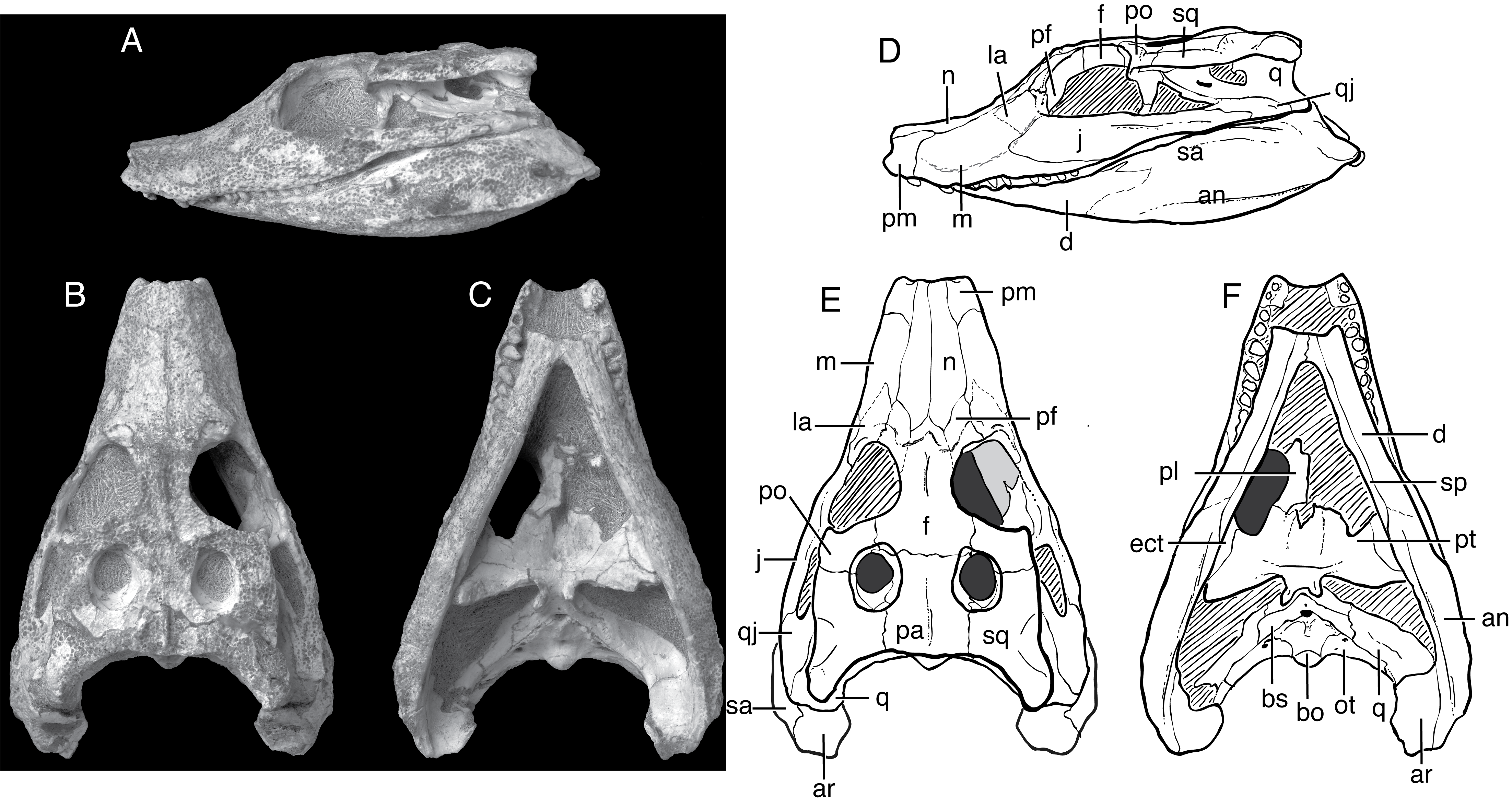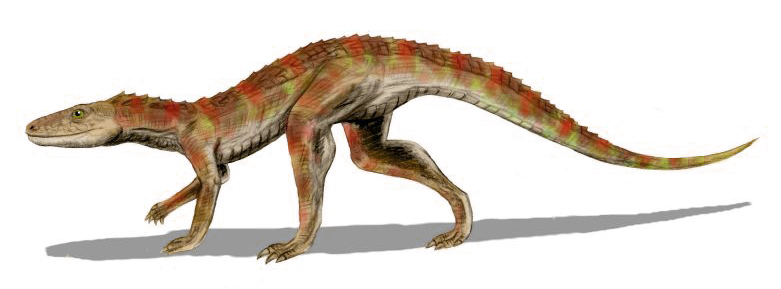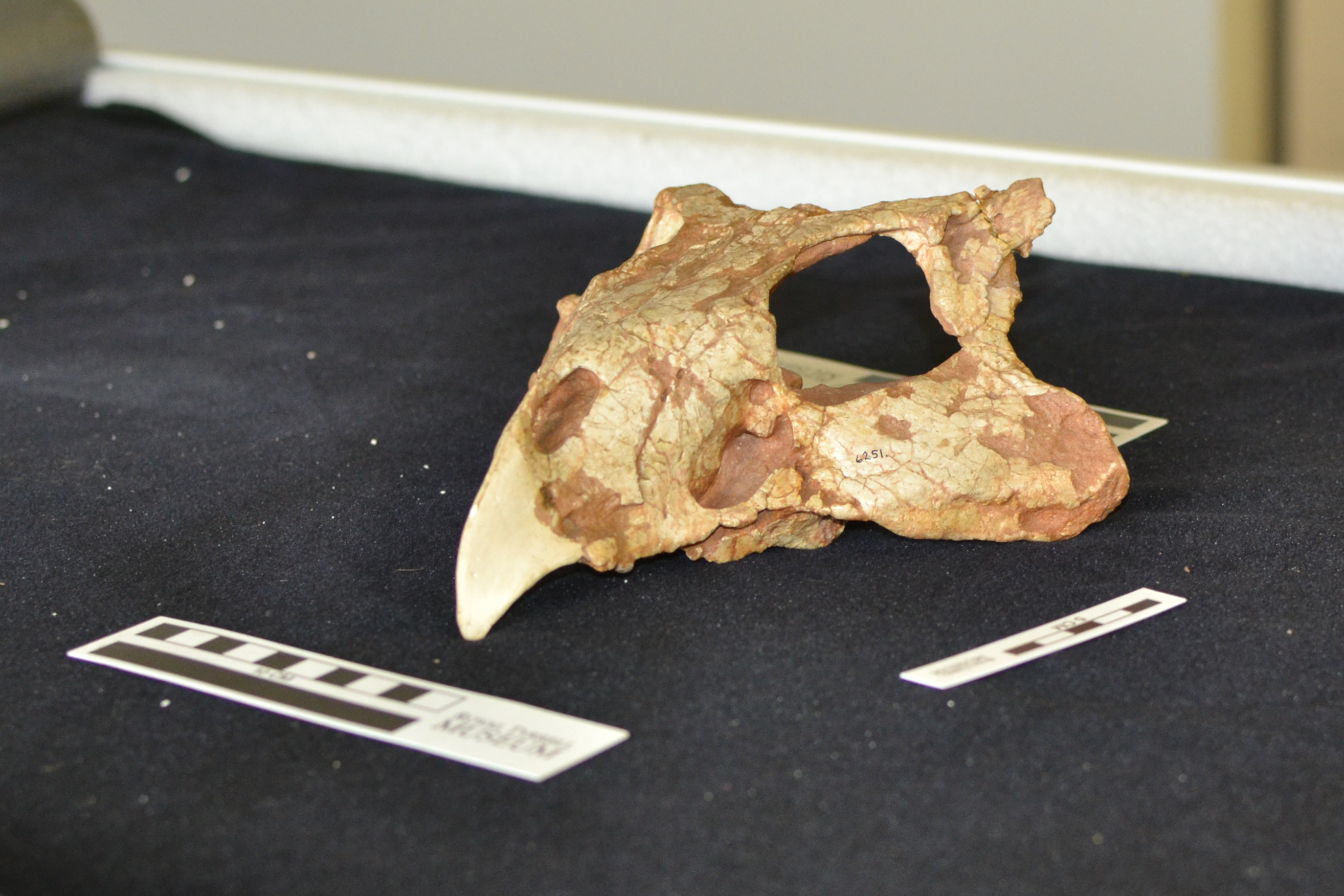|
Bayan Mandahu
The Bayan Mandahu Formation (also known as Wulansuhai Formation or Wuliangsuhai Formation) is a geological unit of "redbeds" located near the village of Bayan Mandahu in Inner Mongolia, China Asia ( Gobi Desert) and dates from the late Cretaceous Period. Laid down in the Campanian, it is dated somewhat uncertainly to between 75 and 71 mya (million years ago). Description The paleoenvironment it preserves was semi-arid and characterized by alluvial (stream-deposited) and eolian (wind-deposited) sediments. The formation is known for its vertebrate fossils, most of which are preserved in unstructured sandstone, indicating burial by wind-blown sandstorms. Paleofauna of the Bayan Mandahu Formation The fauna of the Bayan Mandahu is very similar in composition to the nearby Djadochta Formation, and the two may have been deposited at roughly the same time. These two formations share many of the same genera, but differ in the makeup of species. For example, the most common mammal in ... [...More Info...] [...Related Items...] OR: [Wikipedia] [Google] [Baidu] |
Geological Formation
A geological formation, or simply formation, is a body of rock having a consistent set of physical characteristics ( lithology) that distinguishes it from adjacent bodies of rock, and which occupies a particular position in the layers of rock exposed in a geographical region (the stratigraphic column). It is the fundamental unit of lithostratigraphy, the study of strata or rock layers. A formation must be large enough that it can be mapped at the surface or traced in the subsurface. Formations are otherwise not defined by the thickness of their rock strata, which can vary widely. They are usually, but not universally, tabular in form. They may consist of a single lithology (rock type), or of alternating beds of two or more lithologies, or even a heterogeneous mixture of lithologies, so long as this distinguishes them from adjacent bodies of rock. The concept of a geologic formation goes back to the beginnings of modern scientific geology. The term was used by Abraham Gottlob Wer ... [...More Info...] [...Related Items...] OR: [Wikipedia] [Google] [Baidu] |
Fauna
Fauna is all of the animal life present in a particular region or time. The corresponding term for plants is ''flora'', and for fungi, it is '' funga''. Flora, fauna, funga and other forms of life are collectively referred to as '' biota''. Zoologists and paleontologists use ''fauna'' to refer to a typical collection of animals found in a specific time or place, e.g. the "Sonoran Desert fauna" or the "Burgess Shale fauna". Paleontologists sometimes refer to a sequence of faunal stages, which is a series of rocks all containing similar fossils. The study of animals of a particular region is called faunistics. Etymology ''Fauna'' comes from the name Fauna, a Roman goddess of earth and fertility, the Roman god Faunus, and the related forest spirits called Fauns. All three words are cognates of the name of the Greek god Pan, and ''panis'' is the Greek equivalent of fauna. ''Fauna'' is also the word for a book that catalogues the animals in such a manner. The term was first used b ... [...More Info...] [...Related Items...] OR: [Wikipedia] [Google] [Baidu] |
Amphisbaenia
Amphisbaenia (called amphisbaenians or worm lizards) is a group of usually legless squamates, comprising over 200 extant species. Amphisbaenians are characterized by their long bodies, the reduction or loss of the limbs, and rudimentary eyes. As many species have a pink body and scales arranged in rings, they have a superficial resemblance to earthworms. While the genus '' Bipes'' retains forelimbs, all other genera are limbless. Although superficially similar to the snakes and blind lizards, recent phylogenetic studies suggest that they are most closely related to wall lizards of the family Lacertidae. Amphisbaenians are widely distributed, occurring in North America, Europe, Africa, South America, Western Asia and the Caribbean. Most species are less than long. Description 200px, left, Close-up of the head of'' Rhineura'' Despite a superficial resemblance to some primitive snakes, amphisbaenians have many unique features that distinguish them from other reptiles. Internally ... [...More Info...] [...Related Items...] OR: [Wikipedia] [Google] [Baidu] |
Mesoeucrocodylia
Mesoeucrocodylia is the clade that includes Eusuchia and crocodyliforms formerly placed in the paraphyletic group Mesosuchia. The group appeared during the Early Jurassic, and continues to the present day. Diagnosis It was long known that Mesosuchia was an evolutionary grade, a hypothesis confirmed by the phylogenetic analysis of Benton and Clark (1988) which demonstrated that Eusuchia (which includes all living crocodylian species) was nested within Mesosuchia. Due to the paraphyly of Mesosuchia, Mesoeucrocodylia was erected to replace Mesosuchia. Several anatomical characteristics differentiate Mesoeucrocodylia from the other crocodylomorph clades. The frontal bones of the skull are fused together into a single compound element, for example. Mesoeucrocodylians possess something of a secondary palate, formed by the posterior extension of sutured palatine bones. The otic aperture of the members of this clade is blocked posteriorly by the squamosal bone. Classification Ph ... [...More Info...] [...Related Items...] OR: [Wikipedia] [Google] [Baidu] |
Shamosuchus
''Shamosuchus'' is an extinct genus of neosuchian crocodyliform that lived during the Late Cretaceous (Campanian) period in what is now the Djadokhta Formation of Mongolia, approximately 75 million to 71 million years ago. Paleobiology The eye and nasal openings were not raised above the skull as in modern crocodilians, so that the animal would have to raise its head completely out of the water to breathe. As this cranial morphology does not suit an ambush predator, it lends support to the idea of a diet of aquatic invertebrates. The teeth were adapted to crush bivalves, gastropods and other animals with a shell or exoskeleton. The genus was named in 1924 by Charles C. Mook. ''Shamosuchus'' reached up to in length. ''Paralligator'' was synonymized with ''Shamosuchus'' by several authors. However, recent cladistic analysis of Paralligatoridae Paralligatoridae is an extinct family of neosuchian crocodyliforms that existed during the Jurassic and Cretaceous periods. It inclu ... [...More Info...] [...Related Items...] OR: [Wikipedia] [Google] [Baidu] |
Crocodylomorph
Crocodylomorpha is a group of pseudosuchian archosaurs that includes the crocodilians and their extinct relatives. They were the only members of Pseudosuchia to survive the end-Triassic extinction. During Mesozoic and early Cenozoic times, crocodylomorphs were far more diverse than they are now. Triassic forms were small, lightly built, active terrestrial animals. The earliest and most primitive crocodylomorphs are represented by " sphenosuchians", a paraphyletic assemblage containing small-bodied forms with elongated limbs that walked upright, which represents the ancestral morphology of Crocodylomorpha. These forms persisted until the end of the Jurassic. During the Jurassic, Crocodylomorphs morphologically diversified into numerous niches, including into the aquatic and marine realms. Evolutionary history When their extinct species and stem group are examined, the crocodylian lineage (clade Pseudosuchia, formerly Crurotarsi) proves to have been a very diverse and adaptive ... [...More Info...] [...Related Items...] OR: [Wikipedia] [Google] [Baidu] |
Velociraptor Osmolskae
''Velociraptor'' (; ) is a genus of small dromaeosaurid dinosaur that lived in Asia during the Late Cretaceous epoch, about 75 million to 71 million years ago. Two species are currently recognized, although others have been assigned in the past. The type species is ''V. mongoliensis''; fossils of this species have been discovered in the Djadochta Formation, Mongolia. A second species, ''V. osmolskae'', was named in 2008 for skull material from the Bayan Mandahu Formation, China. Smaller than other dromaeosaurids like ''Deinonychus'' and ''Achillobator'', ''Velociraptor'' was about long with a body mass between . It nevertheless shared many of the same anatomical features. It was a bipedal, feathered carnivore with a long tail and an enlarged sickle-shaped claw on each hindfoot, which is thought to have been used to tackle and restrain prey. ''Velociraptor'' can be distinguished from other dromaeosaurids by its long and low skull, with an upturned snout. ''Velociraptor'' ( ... [...More Info...] [...Related Items...] OR: [Wikipedia] [Google] [Baidu] |
Protoceratops Hellenikorhinus
''Protoceratops'' (; ) is a genus of small protoceratopsid dinosaurs that lived in Asia during the Late Cretaceous, around 75 to 71 million years ago. The genus ''Protoceratops'' includes two species: ''P. andrewsi'' and the larger ''P. hellenikorhinus''. The former was described in 1923 with fossils from the Mongolian Djadokhta Formation, and the latter in 2001 with fossils from the Chinese Bayan Mandahu Formation. ''Protoceratops'' was initially believed to be an ancestor of ankylosaurians and larger ceratopsians, such as ''Triceratops'' and relatives, until the discoveries of other protoceratopsids. Populations of ''P. andrewsi'' may have evolved into '' Bagaceratops'' through anagenesis. ''Protoceratops'' were small ceratopsians, about long and in body mass. While adults were largely quadrupedal, juveniles had the capacity to walk around bipedally if necessary. They were characterized by a proportionally large skull, short and stiff neck, and neck frill. The frill was lik ... [...More Info...] [...Related Items...] OR: [Wikipedia] [Google] [Baidu] |
Velociraptor Mongoliensis
''Velociraptor'' (; ) is a genus of small dromaeosaurid dinosaur that lived in Asia during the Late Cretaceous epoch, about 75 million to 71 million years ago. Two species are currently recognized, although others have been assigned in the past. The type species is ''V. mongoliensis''; fossils of this species have been discovered in the Djadochta Formation, Mongolia. A second species, ''V. osmolskae'', was named in 2008 for skull material from the Bayan Mandahu Formation, China. Smaller than other dromaeosaurids like ''Deinonychus'' and ''Achillobator'', ''Velociraptor'' was about long with a body mass between . It nevertheless shared many of the same anatomical features. It was a bipedal, feathered carnivore with a long tail and an enlarged sickle-shaped claw on each hindfoot, which is thought to have been used to tackle and restrain prey. ''Velociraptor'' can be distinguished from other dromaeosaurids by its long and low skull, with an upturned snout. ''Velociraptor'' (com ... [...More Info...] [...Related Items...] OR: [Wikipedia] [Google] [Baidu] |
Protoceratops Andrewsi
''Protoceratops'' (; ) is a genus of small protoceratopsid dinosaurs that lived in Asia during the Late Cretaceous, around 75 to 71 million years ago. The genus ''Protoceratops'' includes two species: ''P. andrewsi'' and the larger ''P. hellenikorhinus''. The former was described in 1923 with fossils from the Mongolian Djadokhta Formation, and the latter in 2001 with fossils from the Chinese Bayan Mandahu Formation. ''Protoceratops'' was initially believed to be an ancestor of ankylosaurians and larger ceratopsians, such as ''Triceratops'' and relatives, until the discoveries of other protoceratopsids. Populations of ''P. andrewsi'' may have evolved into ''Bagaceratops'' through anagenesis. ''Protoceratops'' were small ceratopsians, about long and in body mass. While adults were largely quadrupedal, juveniles had the capacity to walk around bipedally if necessary. They were characterized by a proportionally large skull, short and stiff neck, and neck frill. The frill was likel ... [...More Info...] [...Related Items...] OR: [Wikipedia] [Google] [Baidu] |
Kryptobaatar Mandahuensis
''Kryptobaatar''and also known as ''Gobibaatar'' or ''Tugrigbaatar'' is an extinct mammalian genus dating from the Upper Cretaceous Period and identified in Central Asia. This animal was a member of the extinct order of Multituberculata within the suborder Cimolodonta, and was a member of the family Djadochtatheriidae. It lived contemporaneously with some of the dinosaurs. Its skull had a length of perhaps 3 cm. The generic name ''Kryptobaatar'' is derived from Greek : ''kruptós'', "hidden," (alludes to the ventral position of infraorbital foramen) and Mongolian : ''baatar'', "hero" (alludes to the name of the capital of Mongolia, Ulan Baatar). The specific name ''dashzevegi'' is named in honour of Mongolian palaeontologist Demberelyin Dashzeveg. The derivation of its synonym ''Gobibaatar parvus'' is Gobi (occurring in the Gobi Desert, Mongolia) and baatar ("a hero", the same as ''Kryptobaatar''). Another synonym ''Tugrigbaatar saichanensis'' is a generic name derived ... [...More Info...] [...Related Items...] OR: [Wikipedia] [Google] [Baidu] |
Kryptobaatar Dashzevegi
''Kryptobaatar''and also known as ''Gobibaatar'' or ''Tugrigbaatar'' is an extinct mammalian genus dating from the Upper Cretaceous Period and identified in Central Asia. This animal was a member of the extinct order of Multituberculata within the suborder Cimolodonta, and was a member of the family Djadochtatheriidae. It lived contemporaneously with some of the dinosaurs. Its skull had a length of perhaps 3 cm. The generic name ''Kryptobaatar'' is derived from Greek : ''kruptós'', "hidden," (alludes to the ventral position of infraorbital foramen) and Mongolian : ''baatar'', "hero" (alludes to the name of the capital of Mongolia, Ulan Baatar). The specific name ''dashzevegi'' is named in honour of Mongolian palaeontologist Demberelyin Dashzeveg. The derivation of its synonym ''Gobibaatar parvus'' is Gobi (occurring in the Gobi Desert, Mongolia) and baatar ("a hero", the same as ''Kryptobaatar''). Another synonym ''Tugrigbaatar saichanensis'' is a generic name derived ... [...More Info...] [...Related Items...] OR: [Wikipedia] [Google] [Baidu] |










